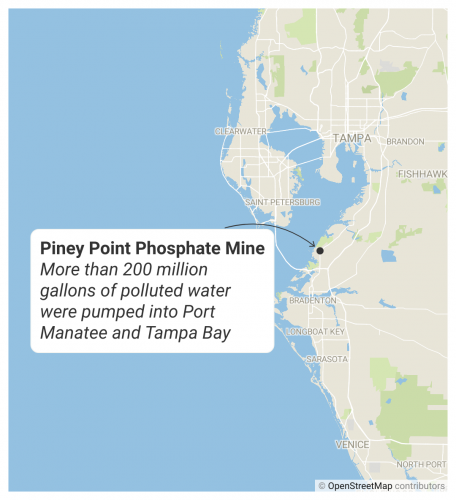Featured image: Tampa Bay (From Flickr user Kimm CC-BY-NC-ND 2.0).
The takeaway message:
Polluted wastewater at an abandoned phosphate mine in Manatee County was pumped into Tampa Bay to stop a leak from flooding surrounding neighborhoods. Stakeholders say this could have consequences for the marine ecosystem.
What’s going on?
In late March 2021, site engineers found a leak in the liner of the Piney Point reservoir pond, where millions of gallons of polluted water from phosphate mining operations were being stored.
Mining activity at Piney Point, located in Manatee County, halted nearly 20 years ago after the mine owners went bankrupt, but leftover contaminants were still being stored on the site.

Phosphate is mined from the ground to be processed into fertilizer. The liner was meant to stop the polluted water from getting into groundwater, which millions of Floridians rely on for drinking and household use. Managers had known for years the liner was in bad shape before the current leak was discovered.
Responding to the risk of catastrophic flooding should the leak become a full-fledged breach in the liner, around 300 homes, as well as businesses and the nearby Manatee County Jail, were evacuated. To reduce pressure on the leak, officials began pumping more than 200 million gallons of the reservoir’s polluted water into Tampa Bay.
In April 2021, the pumping was halted to allow officials to use technology to treat the remaining water before releasing more. Florida State Senator Jim Boyd introduced an amendment to the state budget April 7 that would allocate $3 million to the effort, but officials noted that total remediation could cost up to $200 million. Florida Gov. Ron DeSantis said that he would also redirect $15.4 million from the Florida Department of Environmental Protection’s existing budget toward the cleanup.
Why it matters.
There are 27 phosphate mines in Florida, but only nine are currently active. After processing phosphate, materials like uranium, thorium, radium and a gas called radon are left behind along with wastewater. The mixture of solid wastes is called phosphogypsum, and it is normally stored in piles, or stacks. The polluted water is normally stored in big reservoirs with liners, like at Piney Point.
The Florida Department of Environmental Protection said the Piney Point water was not radioactive. However, conservation organizations say the elevated levels of nitrogen and phosphorus that are in the water that was pumped into Tampa Bay are still concerning.
In excess, these nutrients can lead to the overgrowth of algae, which can block sunlight from penetrating the water and reaching beneficial plants. Fish kills, toxic algae blooms and dead zones are problems that can result from having too many nutrients in a marine ecosystem.
“We hope the contamination is not as bad as we fear, but are preparing for significant damage to Tampa Bay and the communities that rely on this precious resource,” said Justin Bloom, Suncoast Waterkeeper founder and board member, in a Center for Biological Diversity press release.
Stakeholders say continued action is needed to remedy the harm caused by the Piney Point leak, and proactive measures need to be taken to stop this situation from happening at waste sites elsewhere in the state.
Updates as of July 2, 2021:
In the months since the spill, Tampa Bay, officials, researchers and residents have been dealing with the consequences – even though the initial wave of polluted water from the spill has dissipated, according to researchers.
Florida’s former chief science officer Tom Frazer told WUSF News that although the discharge didn’t cause the red tide along Florida’s west coast, the nutrient-laden wastewater that leaked from the phosphate plant may have helped fuel existing bloom outbreaks. Other source-points for the excess nutrients that feed algal blooms could include runoff from nearby septic tanks, the region’s 18 stormwater systems and agricultural and residential fertilizers. This red tide not only devastates marine ecosystems, but it also wreaks havoc on surrounding aquaculture industries, causing pauses in production and potential contamination issues.
In late June, five environmental groups officially filed a lawsuit in federal court against the governor, state and operators of the now-closed Piney Point phosphate plant. It asks a federal judge to oversee the clean-up, closure and investigation of the old plant site and to ensure the waste is properly disposed of.
“The purpose of the lawsuit is to seek a full and final closure of Piney Point, to make sure that there’s adequate remediation of the site, to seek accountability,” Justin Bloom, an affiliate with plaintiff Tampa Bay Waterkeeper, told WUSF News, “particularly by the regulators, who dropped the ball here.”
Bloom also said that he hopes this suit will help strengthen state regulation of other gypsum stacks around the state. Mosaic, a phosphate plant in Polk County, Florida, is the largest phosphate producer in the world – and workers say they’re working 24/7 to make sure they don’t make the same mistakes as Piney Point, although natural disasters have rattled the site before.
Updates as of April 25, 2022:
Visit our latest post about the Piney Point disaster as well as our interactive timeline to learn more about the long and troubled history of the plant.
What can I do?
- Keep up with the Piney Point situation and the latest developments
- Reduce the amount of nutrients you put into the environment by following best practices
- Support organizations that are working to conserve Florida’s waterways
Learn more:
- About phosphate mining and gypsum stacks
- About where other phosphate stacks are located in Florida
- About the significance of phosphorus